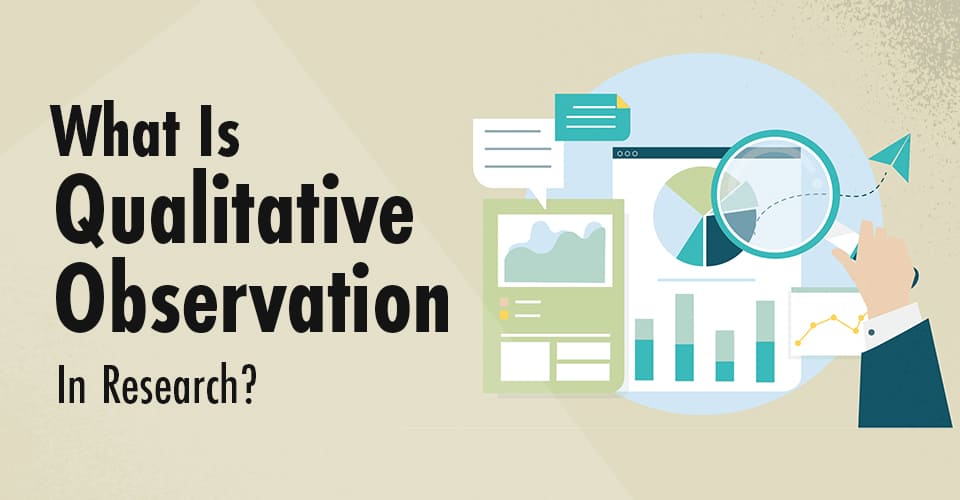
What Is Qualitative Observation in Research?
In the vast landscape of research methodologies, there exists a lens through which data transforms into stories, behaviors into insights, and contexts into understanding. This lens is Qualitative Observation. Far from the realm of numbers and statistics, it delves into the intricate nuances of human behavior, interactions, and environments. It's a method that lets us step into the shoes of participants, see the world through their eyes, and capture the essence that numbers can't grasp.
In this succinct journey, you'll unwrap the essence of what is a qualitative observation in research, exploring its significance, methodologies, and the unique perspectives it unveils.
Definition of Qualitative Observation
Qualitative observation is a research methodology that seeks to understand the rich tapestry of human behaviors and experiences. Unlike quantitative methods that rely on numbers, qualitative observation delves into the intricacies that color our world. It involves keenly observing and documenting interactions, behaviors, and contexts, often within natural settings.
This method goes beyond statistics, capturing the essence of emotions, motivations, and the unspoken. Qualitative observation provides a holistic understanding, allowing researchers to uncover the deeper layers that quantitative data might miss. It's an art that transforms observation into insight, and stories into knowledge.
However, if you’re assigned multiple essay writing tasks that follow the qualitative observation approach and are struggling to take external help because of a limited budget then don’t worry! Simply search for cheap dissertation writing services UK-based companies and get a list of the best ones that offer budget-friendly services.
Types of Quantitative Observations
Participant Observation
Participant observation is more than a research method; it's an experience. Researchers become integral parts of the environment they study, embedding themselves in the subjects' world. This approach offers a unique perspective, allowing researchers to witness behaviors, interactions, and nuances from the inside. It's a journey of empathy, where insights arise not just from observation but from lived experiences. This method is particularly useful when studying intricate social dynamics, cultural practices, or contexts where a researcher's involvement enriches understanding.
However, if you’re instructor has asked you to write a research paper implementing the participant observation method and you’re unable to do so then consider to pay someone to do your dissertation to get the best from writing experts!
Non-Participant Observation
While participant observation immerses researchers in the heart of the action, non-participant observation adopts the role of a silent observer. Researchers step back, capturing behaviors and interactions without direct involvement. This method offers a certain level of objectivity, allowing for unbiased insights into social dynamics. It's akin to being a fly on the wall, capturing the natural flow of interactions without influencing them.
Non-participant observation is particularly valuable when studying phenomena where a researcher's presence might alter the subjects' behaviors or settings that require a distant perspective.
Structured Observation
Structured observation is the research equivalent of precision engineering. Researchers define specific behaviors, interactions, or criteria they're looking for and create a structured framework to capture them. This method ensures consistency and allows for systematic data collection. Researchers follow predefined categories, making it easier to compare findings across different observations or observers. Structured observation is valuable when seeking to answer specific research questions or when a focused approach is essential.
Unstructured Observation
Unstructured observation is like an artistic brushstroke on the canvas of research. Here, researchers step into the environment with an open mind, capturing a wide array of behaviors, interactions, and contexts. This approach is flexible and allows for the exploration of unexpected insights. It's particularly useful when the researcher is still forming questions or hypotheses, as it allows for the discovery of nuances that might have been overlooked in a structured approach. Unstructured observation brings depth and richness to the understanding of complex behaviors and environments.
Quantitative Research Observation Methods
Quantitative research observation methods are the scientific compass that navigates the world of numbers and patterns. These methods transform behaviors, interactions, and phenomena into measurable data, offering a structured approach to understanding. Structured observation, a cornerstone of quantitative research, involves predefined categories and behaviors. It ensures consistency across observations, enhancing data reliability.
Despite their advantages, quantitative methods may miss the context captured by qualitative approaches. However, they remain crucial in fields like market research, education, and healthcare, where numeric insights illuminate trends, correlations, and measurable outcomes. However, if you’re a final year student and are in search of the best topics for dissertation then the best yet trendiest one that you can opt for is “Is observation qualitative or quantitative”. This topic will not only provide you with valuable insights for your thesis but will also aid you in grabbing an A*.
Structured Observation in Quantitative Research
The structured observation in quantitative research stands as the backbone of quantitative research, offering a methodical lens to dissect behaviors and interactions. This approach involves predetermined criteria that guide data collection. Researchers meticulously record specific actions within controlled settings, ensuring consistency and objectivity. Structured observation allows for targeted data acquisition, enabling systematic analysis and comparison.
This method's rigorous framework facilitates reliable results, making it invaluable for studies seeking quantifiable insights. Whether in the realms of psychology, sociology, or natural sciences, structured observation in quantitative research paves the way for precision and depth in understanding.
Advantages and Disadvantages of Quantitative Observations
Advantages of Quantitative Observations
Objectivity:
Quantitative observation's numerical nature offers a certain objectivity, reducing potential biases in interpretation.
Standardization:
Structured observation methods enhance standardization, enabling multiple observers to record data consistently.
Data Analysis:
Quantitative data lends itself to various statistical analyses, allowing for deeper insights into patterns and relationships.
Comparability:
The numerical data obtained through quantitative observation makes it easy to compare findings across different contexts or timeframes.
Disadvantages of Quantitative Observations
Quantitative observation methods find application across diverse fields, translating behaviors into numeric insights:
Limited Context:
Quantitative observation may miss the depth and context that qualitative methods provide, limiting the understanding of complex behaviors.
Reduced Flexibility:
Structured observation methods, while enhancing consistency, may limit researchers from capturing unexpected or unanticipated behaviors.
Human Complexity:
Quantitative observation might not fully capture the complexities of human behavior and interactions.
Examples of Quantitative Observation
Quantitative observation methods find application across diverse fields, translating behaviors into numeric insights:
Market Research:
In a retail setting, observing shoppers' paths, time spent per aisle, and product choices quantifies consumer behavior, aiding in understanding purchasing patterns.
Educational Studies:
Observing classroom dynamics, recording instances of teacher-student interactions, and measuring engagement levels provide data for analyzing effective teaching strategies.
Healthcare Research:
Monitoring patient responses to treatments, noting vital sign changes, and recording recovery times contribute to evidence-based medical interventions.
Environmental Studies:
Tracking animal behavior in their natural habitats, and recording feeding frequencies, and movement patterns offer insights into ecological dynamics.
Criminal Justice:
Observing crime rates, arrest frequencies, and conviction rates over time provides quantitative data to evaluate the effectiveness of law enforcement policies.
These examples of qualitative observation showcase how these methods translate complex behaviors into tangible data points, unraveling patterns that drive evidence-based decision-making across various domains.
Conclusion
In conclusion, qualitative observation stands as a cornerstone of research, delving into the intricate threads of human behavior and phenomena. Its counterpart, quantitative observation, offers numerical precision and statistical insights. Both approaches enrich the understanding of the world, providing lenses through which you can fathom the mysteries that surround us. The choice between them depends on the research question, the depth of understanding sought, and the level of objectivity desired. Just as the world is multifaceted, research methods must be equally diverse, intertwining to illuminate the grand tapestry of knowledge.
However, if you’re struggling in writing your final year dissertation because of poor writing skills then the best possible solution for you is to buy dissertation online UK-based and enjoy the perks of it!
